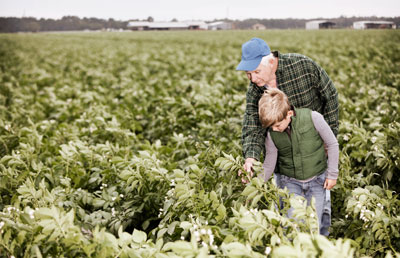Some Examples of Destination Based Cash Flow Tax

There is a lot of chatter currently in the news regarding proposed tax reform especially the “destination based cash flow tax” which is being touted as a form of a value-added tax. If this were simply an income tax, the World Trade Organization (WTO) would likely view it negatively.
Under this tax, the key issues facing the law makers (and farmers) is how imports and exports will be taxed. If your operation is a corporation, it will be taxed at a 20% rate. If you operate as an S corporation or partnership, your tax rate would be 25%. But first, let’s review the major components of this new tax:
- You will continue to account for all of your income and deductions,
- You will be able to deduct all of your capital improvements such as equipment and buildings in full in the year of purchase (you cannot deduct land purchases),
- You will not be able to deduct your business interest expense except you can offset it against your business interest income (any excess is allowed to be carried forward),
- You can no longer carry back net operating losses (NOL), but will be able to carry forward them indefinitely; you can only deduct 90% of your net income in any year from an NOL; they will be indexed to inflation and a real return to capital,
- Exported sales will be tax-free
- Imported cost of sales and expenses will be non-deductible.
The last two points are the most hotly contested items in the debate. Some industries such as oil refineries, auto companies, retail companies will incur a net increase in their income taxes since they export very little and import a lot. Other industries such as manufacturing, agriculture (in some cases), etc. may see their taxes dramatically reduced or even eliminated. Let’s review how this may affect a farm operation:
Example # 1 – Farmer Anderson farms as a corporation and has crop sales of $2 million, cash expenses of $1 million and buys $750,000 of equipment during the year (he has fully depreciated all other assets in previous years). He also incurs $75,000 of interest expense. Under current tax laws, his net income would be about $300,000 (assuming full Section 179 of $500,000 and 50% bonus depreciation on his equipment). This would result in total tax owed of slightly more than $100,000 (ignoring state income taxes).
Now let’s assume that all of the sales are within the US and none of his costs are imported goods. In this case, his taxable income would now be $250,000 (sales minus cash costs minus all equipment purchases; interest expense is not allowed). At a 20% tax rate, his taxes are now $50,000.
Example # 2 – Assume same facts as in # 1, but let’s assume that $500,000 of his sales are exported. Now, his taxable income is actually a loss of $250,000 which he can carry forward to the next year and use to offset income in that year (limited to 90% of total income).
Example # 3 – Assume same facts as #1, but let’s assume that $350,000 of his cash costs relates to imports of chemicals, fertilizers and fuel. In this case, his taxable income will increase from $250,000 to $600,000 and his tax will now be $120,000.
As you can see, depending on your mix of exported sales and imported costs, your actual tax liability can be either much higher or much lower under this tax reform proposal. Some farmers who export a lot of grain or livestock may not ever pay tax again. Others that have no exports and import some of their inputs and have high interest costs may see their income tax go up dramatically.
However, as with all tax reform proposals, it may never reach the finish line, but it is very important to know what might happen so you can be prepared or reach out to your representatives.
Paul Neiffer is a certified public accountant and business advisor specializing in income taxation, accounting services, and succession planning for farmers and agribusiness processors. Paul is a principal with CliftonLarsonAllen in Walla Walla, Washington, as well as a regular speaker at national conferences and contributor at agweb.com. Raised on a farm in central Washington, he has been immersed in the ag industry his entire life, including the last 30 years professionally. Paul and his wife purchase an 180 acre ranch in 2016 and enjoy keeping it full of animals.

Does the farmer have to export his commodities directly or if the COOP he sells to exports their grain, does that flow back to the farmer that sold to that COOP?